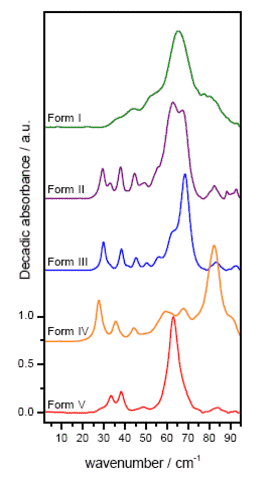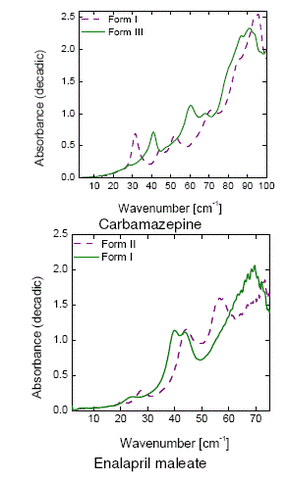Crystalline solids
Terahertz spectroscopy is a very exciting technique for the physico-chemical characterisation of organic molecular crystals (such as typical drug molecules). The ability to probe hydrogen bonding networks and phonon modes in molecular crystals allows us to gather information about the supramolecular structure in solids with very high sensitivity. We have applied this technique towards the study of crystal polymorphs, cocrystal formation and phase transformations in crystals.
Polymorphism is the ability of a solid to exist in more than one crystal form. The ability to distinguish between different crystal polymorphs is an area of great importance in the pharmaceutical industry because patents often only cover one polymorph, so the accurate determination of polymorphism has huge impact at the legal level. Additionally, different polymorphs may have different physiochemical properties that affect manufacturing processes and therapeutic effects. THz-TDS has been shown to be an ideal technique in this field because the structural information it provides enables crystal polymorphs to be readily differentiated and is a rapid completely non-destructive method.


The sensitivity to phonon modes in crystals also allows for crystallinity in compounds to be easily determined. As with polymorphism, variations in the degree of crystallinity in pharmaceutical compounds can affect their therapeutic properties and commercial value. We have also shown THz-TDS to be a useful tool in determining the level of crystallinity in compounds.
Cocrystals are crystalline structures made up of two or more components in definite stoichiometric ratios. They have been widely studied for applications in drug formulation, where engineered cocrystals can aid in enhancing the bioavailability of drugs. Since THz-TDS is sensitive towards different supramolecular structures in crystals, we have demonstrated that it can be used to study cocrystal formation as well.
Key Publications
C.J. Strachan, P.F. Taday, D.A. Newnham, K.C. Gordon, J.A. Zeitler, M. Pepper, and T. Rades, Using terahertz pulsed spectroscopy to quantify pharmaceutical polymorphism and crystallinity, Journal of Pharmaceutical Sciences, doi:10.1002/jps.20281, 94, 837-846 (2005).
K.L Nguyen, T. Friscic, G.M. Day, L.F. Gladden and W. Jones, Terahertz time-domain spectroscopy and the quantitative monitoring of mechanochemical cocrystal formation, Nature Materials, doi:10.1038/nmat1848, 6, 206-209 (2007).
E.P.J. Parrott, J.A. Zeitler, T. Friš?i?, G.M. Day, L.F. Gladden, M. Pepper and W. Jones, Testing the sensitivity of terahertz spectroscopy to changes in molecular and supramolecular structure: A study of structurally similar cocrystals, Crystal Growth and Design, doi:10.1021/cg8008893, 9, 1452-1460 (2009).
Dynamics in Biomolecules
Computational studies predict that the collective vibrational modes of biomolecules fall in the terahertz frequency range. Therefore, THz-TDS is regarded as an extremely promising technique with which to study the dynamics and conformational changes of biomolecules such as proteins and peptides in aqueous environments. Rather than merely the chemical properties, the secondary physical structure and the dynamics of transitions between them are known to be key to understanding the biological function.
